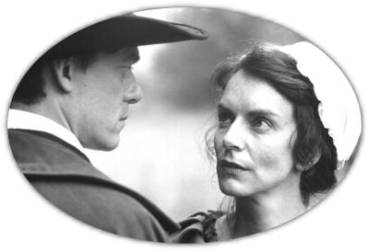Paper #2
|
War on the Due
May 1 |
|
The film, Mary Silliman's War, suggests that the Revolutionary War was not simply a military conflict between American military men and British Regulars but was a war for the "hearts and minds" of citizens on the home front, a civil war between neighbors, and sometimes a conflict between friends and among families. Students should think of the film as a "document" to be studied, digested, and then analyzed like any other text encountered in studying a subject. Use this "film document" along with documents and readings in Brown (288-294, 296-305), a brief web reading (The Wars of the American Revolution), and material in the Foner text (pp. 216-218, 246-251, for example) to discuss the issues outlined below.
Mary Silliman's War is a film about one woman and her family during the American Revolution. It is essentially a true story based on the biography of Mary Fish Silliman, The Way of Duty: A Woman and Her Family in Revolutionary America (1984) by Joy and Richard Buel, and upon family correspondence, her journal, and her reminiscences written after the war.
The story takes place in Fairfield, Conn., in 1779 during the 4th year of the American Revolution. Mary's husband Selleck is an ardent Patriot and state's attorney tasked with prosecuting local Tories. When he helps convict two Tories and they are sentenced to hang, a dramatic series of events unfold which forces Mary from her traditional domestic duties into the arena of war and revolutionary politics.
Main characters in film include:
- Mary
Silliman (1736-1818) - Connecticut housewife
- Selleck Silliman (1732-1790) - Mary's husband, militia
general, Patriot state's attorney
- Amelia
- servant in Silliman household
- Captain
David Hawley (1741-1807) - privateer
- Peter
- older slave in Silliman household
- Reverend
Elliot - town minister and long-time friend of Mary's
- Abby
Nash - midwife, friend of Mary's
- Capt.
Tom Nash – Abby’s husband, militia leader
- Governor
Trumbell & Council – governor of Connecticut
and members of the state council
- Adam
Sayres - field and tavern worker, Loyalist(Tory)
- Judge
Thomas Jones (1731-1792) - New York Loyalist(Tory) and college classmate
of Selleck Silliman
- Isaac
Bunnell - local Loyalist(Tory) militia leader
A 6-page paper is due in class on May 1. The major task for the paper is to place Mary Silliman within the context of women's war-time activities and thoughts as described in Linda Kerber's article (Brown, 296-305), and in comments by Thomas Paine, John and Abigail Adams, and others (Brown, 288-294). Where does Mary Silliman "fit" into these patterns? Did she respond to the War in the same ways as other American women? What non-traditional roles and duties does she undertake? Does Mary change during the course of the film? Does Mary advocate stronger roles for women? Who is Mary most like; would she agree with the ideas of Thomas Paine, or Abigail or John Adams, or "An American Woman" (Brown, 288-294)?
As a secondary task, you should also consider one of the issues listed below and
relate them to Mary and women's wartime experiences. Use these issues to
help sharpen your analysis of Mary and other Revolutionary women:
(1) How does the concept of "community"
affect Mary's actions throughout the film? How does it affect the actions
of other women?
(2) What is the impact of religion
on Mary's actions throughout the film? What is the impact of religion on
the actions of other women?
Be sure to footnote any material from Brown book or any other sources used in the paper. If direct quotations are used, they should be surrounded by quotation marks [" "]. Please do not over-quote, the paper should be primarily your words. Quotations, specific references to information from Brown, and any other source you use to prepare the paper must be referenced with a footnote indicating the location of the information. Again, use the automated footnote feature in Word to produce the footnotes. Double-spaced in 10-12 point type.
A footnote should include a superscripted reference number at the end of a sentence or paragraph in the text of the paper and the citation at the bottom of the page, such as:
1Linda K. Kerber, "The Revolution and Women's Rights," in Richard D. Brown, ed., Major Problems in the Era of the American Revolution, 1760-1791, 2nd. ed. (Boston, 2000), 298.
2Abigail Adams to John Adams, 31 March 1776, in Brown, Major Problems, 290.
3Mary Silliman’s War [videorecording]; Claremont, CA: Heritage Films, 1993.
4Kerber, 302.
5Mary Silliman's War [videorecording].
